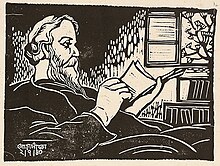art.wikisort.org - Artist
Chittaprosad Bhattacharya (1915-1978) was a political artist of the mid-20th century. He preferred watercolor and printmaking, avoiding oil on canvas. Chittaprosad used prints to disseminate leftist ideas and propaganda.[1]
Chittaprosad Bhattacharya | |
|---|---|
 | |
| Born | Chittaprosad Bhattacharya 21 June 1915 Naihati, Calcutta, India |
| Died | 13 November 1978 (aged 63) Kolkata, India |
Early life

Born in 1915 in Naihati in present-day North 24 Parganas District, West Bengal,[2] Chittaprosad became radicalized as a student of the Chittagong Government College in the mid-1930s. He joined the grassroots movement to resist both colonial oppression by the British, and also the feudal oppression of the landed Indian gentry. Chittaprosad rejected the classicism of the Bengal School and its spiritual preoccupations.[1] Due to his refusal to accept the discriminations of the caste system, Chittaprosad never used his Brahminical surname during his life.[3] He wrote articles and produced incisive cartoons and illustrations that displayed a natural talent for draughtsmanship.[1]
Career and style

Chittraprosad’s most creative years began in the 1930s. He satirized and sharply criticized the feudal and colonial systems in quickly drawn but masterful pen and ink sketches. As an artist, and reformer, Chittaprosad was also proficient at creating linocuts and woodcuts with obvious propagandistic intent.[1] Since these cheaply made prints were created for the masses, rather than the art gallery, they were seldom signed or numbered. With time, they took on commercial value as art, and today are prized by collectors.[4]
In 1943, Chittaprosad covered the Bengal Famine for various communist publications. This resulted in his first publication, Hungry Bengal. It was a sharply provocative attack on the political and social powers of the time, and the Indian authorities suppressed it nearly immediately, impounding and destroying large numbers.[5]
Chittaprosad settled more permanently in Bombay from 1946 onward. The transformations that the Communist Party took between 1948 and 1949, caused the artist to disassociate himself, though he continued to pursue political themes in his art to the end of his life. In the years before his death, Chittaprosad devoted more and more time to the world peace movement,[clarification needed] and various efforts to help impoverished children.[5]
He is represented in the National Museum in Prague, The National Gallery of Modern Art in New Delhi, Osians Art Archive in Mumbai, and the Jane and Kito de Boer Collection in Dubai.[1]
References
- Manifestations II, Roobina Karode, Delhi Art Gallery 2004, ISBN 81-902104-0-8
- Sen, Arup Kumar (March 5, 2016). "Chittaprosad Bhattacharya (1915–78)". Economic & Political Weekly. Vol. LI, no. 10.
- Manifestations I, Santo Datta, Delhi Art Gallery, 2003, New Delhi
- Collection of Indian Printmaking, www.waswoxwaswoartcollection.blogspot.com
- Manifestations III, Geeta Doctor, Delhi Art Gallery, 2005, ISBN 81-902104-1-6
External links
| Wikimedia Commons has media related to Chittaprosad Bhattacharya. |
Другой контент может иметь иную лицензию. Перед использованием материалов сайта WikiSort.org внимательно изучите правила лицензирования конкретных элементов наполнения сайта.
WikiSort.org - проект по пересортировке и дополнению контента Википедии